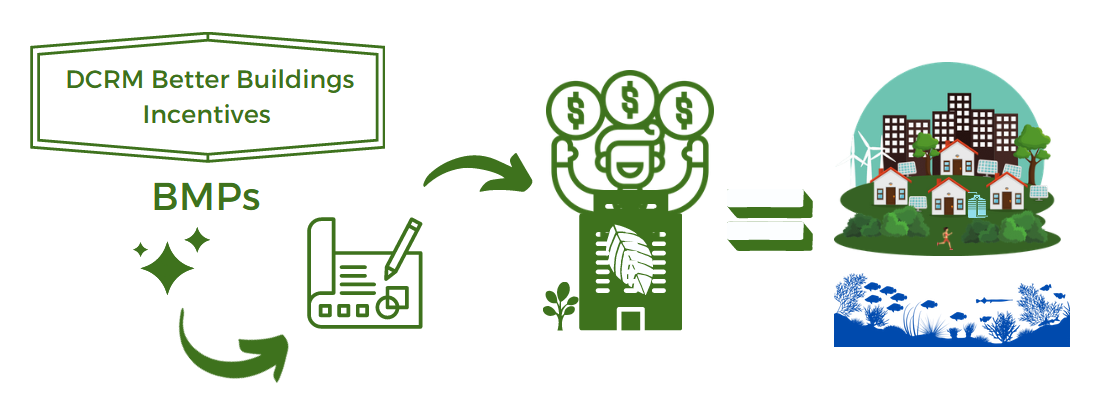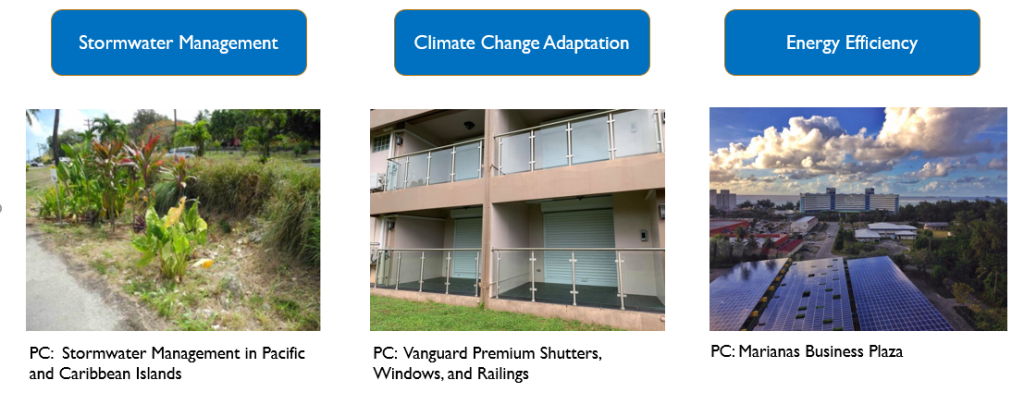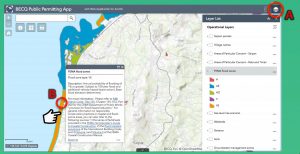Better Buildings Incentives Program
General information
Do you have a Major Siting Project or planning a big development project?
Choose to use best management practices (BMPs) into your design plans. Get awarded a discount on your DCRM permit!

To promote sustainable development in the CNMI, DCRM is incentivizing the use of best management practices (BMPs) in major siting developments. These BMPs are GOOD for you and your structure. They intend to improve your development project’s resilience to climate change impacts, especially flooding, and energy efficiency. They also help minimize new developments’ environmental footprint on seagrasses, corals, and wetlands. See the “Quick Table of DCRM’s ‘Better Building’ Incentives” below!

Why “better buildings”?
Development in the CNMI, like elsewhere, adds pressure on the natural environment. We can build differently and better to incorporate our natural environment. Natural components can benefits us! In addition, we need to better prepare for climate change impacts such as:
- Increased heavy rainfall events that increase runoff and erosion OR seasonal drought (dependent on ENSO)
- Stronger storms
- Rising sea levels
- Hotter temperatures

Coastal hazards (such as flooding, typhoon winds, etc) have damaged building structures and continue to pose higher risks under climate change. These smart BMPs intend to address these on-going problems so that the development would be built to last under these conditions.
DCRM is providing incentives to encourage developers to consider these sustainable, low-impact development practices before and during the siting phase because they are:
LEARN MORE and HOW TO APPLY Better for the Environment – Better for the Structure – Better Savings and Returns – Resilient, low-impact development are unlikely to to deal with the costs from storm damages and rising gas prices, resulting in long-term savings! Established in 2022, the Better Buildings Incentives Program aims to promote low-impact development through better building best management practices. This program promotes the Smart, Safe, Growth principles: 1) Climate Change, 2) Retreat, 3) Retrofit, 5) Development Incentives, 8) Green Infrastructure, 10) Early Collaboration. NMIAC § 15-10-335 in the DCRM Rules and Regulations has been updated to include new low-impact development incentives (see the table above). Now, DCRM mandates the evaluation of impacts, such as sea level rise, using the best available science. Additional requirements for acquiring the incentive: Instructions for easy reading: Each row is a different incentive and the columns provide additional information. View Table Better Buildings Practices in the CNMI: Addressing Coastal Hazards Through Responsible Development and Resiliency provides guidance for how developers can incorporate “Better Buildings” practices into their project design and avail the incentive. The Executive Summary section of the guidebook, page ii – x, is available in Korean, Chinese, and Japanese. Physical copies are free and available at the DCRM Permitting Office.
how to apply for a permit discount?
quick table of DCRM’s “Better Building” incentives:
DCRM Better Buildings Incentives Table
Best Practice Category Tier Description Fee reduction (%)
LEED 1 Building design and construction are
“LEED Certifiable,” scoring between
40-49 points on the LEED v4 or subsequent 10
LEED 2 Building design and construction are “LEED Silver Certifiable,” scoring
between 50-59 points on the LEED v4 or subsequent Building Design and Construction
Checklist15
LEED 3 Building design and construction are “LEED Gold Certifiable,” scoring between 60-79 points on the LEED v4 or subsequent
Building Design and Construction Checklist
20
LEED 4 Building design and construction are “LEED Platinum Certifiable,” scoring
between 80-110 points on the LEED v4 or subsequent Building Design and Construction
Checklist25
Building Redevelopment 2 Applicant redevelops or rehabilitates
15% - 25% of the existing building
10
Building Redevelopment 3 Applicant redevelops or rehabilitates
26% - 50% of the existing building
20
Building Redevelopment 4 Applicant redevelops or rehabilitates
51% - 74% of the existing building
30
Building Redevelopment 5 Applicant redevelops or rehabilitates
over 75% of the existing building
50
Recycling and Composting Programs 1 Permittee or its operators implements and maintains on site recycling and composting programs to reduce 50% or
more of the waste stream5
Energy Efficiency 1 Project installs, utilizes, and maintains “Energy Star” rated high efficiency / LEED lighting and appliances or a renewable energy source supplying 20% or more of a project’s electricity 5
Stormwater Management 1 Project implements and maintains on-site stormwater management practices that collect from an off-site source and treat or contain an additional 10%-24% of the project's total stormwater runoff volume, based on the 25 year 24 hour duration storm event; AND/OR Project implements and maintains 30%-49% of pervious surface area or green infrastructure elements 5
Stormwater Management 2 Project implements and maintains on-site stormwater management practices that collect from an off-site source and treat or contain an additional 25%-49% of the project's total stormwater runoff volume, based on the 25 year 24 hour duration storm event; AND/OR Project implements and maintains 50% or more of pervious surface area or green infrastructure elements 10
Stormwater Management 3 Project implements and maintains on-site stormwater management practices that collect from an off-site source and treat or contain an additional 50%-74% of the project's total stormwater runoff volume, based on the 25 year 24 hour duration storm event; 20
Stormwater Management 4 Project implements and maintains on-site stormwater management practices that collect from an off-site source and treat or contain an additional 74% of the project's total stormwater runoff volume, based on the 25 year 24 hour duration storm event 30
Stormwater Management 4 Project implements and maintains on-site stormwater management practices that collect from an off-site source and treat or contain an additional 74% of the project's total stormwater runoff volume, based on the 25 year 24 hour duration storm event 30
read our guidebook

